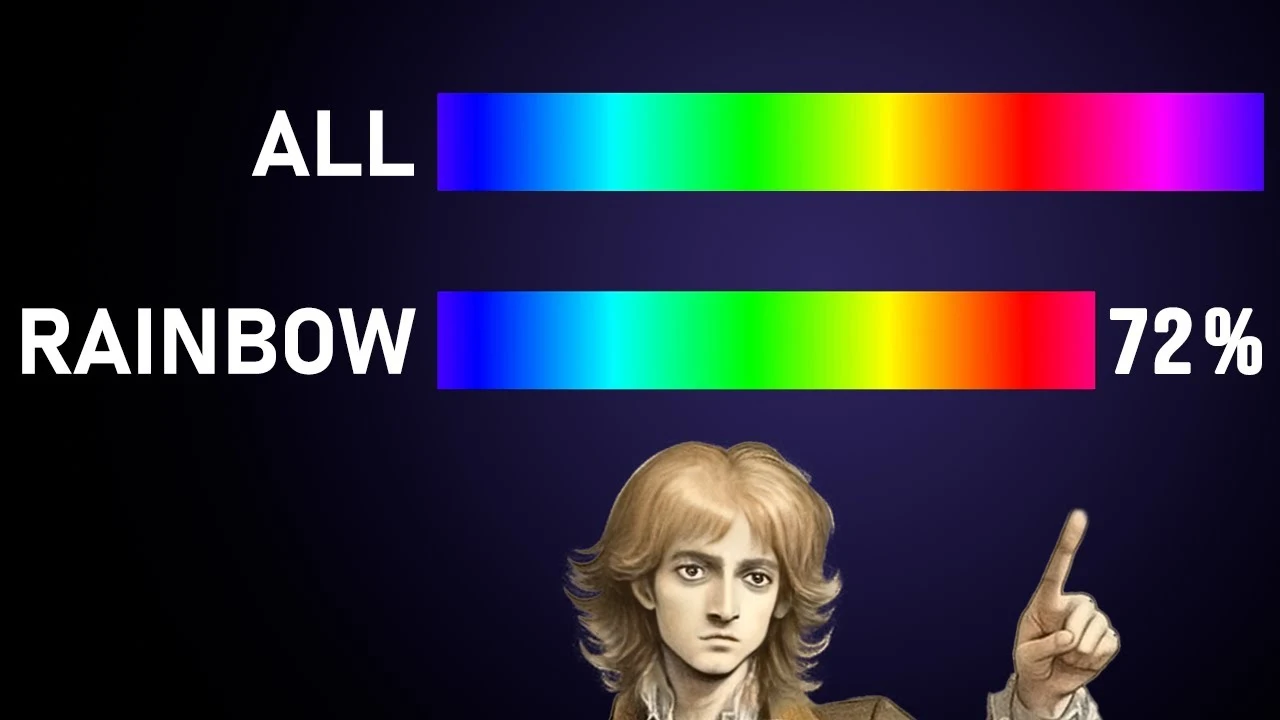Did someone tell you rainbows contain all the colors? Well, that’s not true! It is missing a whopping 28% of colors!🌈
72% of all hues.
The space of visible colors is three-dimensional, and the spectrum is missing two dimensions (brightness and saturation). You can’t assign a percentage to that.
Exactly! And that is what I say in the video. Just that I tried to find a simple title.
… also there are different choices for the scaling of the hue axis, so the percentage can change. This is also noted in the vid.
Well there is wavelength and intensity, an all together it is called a spectrum. No need for a third parameter. Also there are mor than 100% of all colors in there, as a quick check on Wikipedia would reveal…
The third parameter is saturation, which comes into play for non-monochromatic (i.e., multiple-wavelength) colors.
I agree
There is no such thing as a mono wavelength color. There are only spectral densities. Or in other words electromagnetic radiation / photons distributed over some energy.
Is this a weird terminology argument? Because there are definitely ways to produce color that output one specific wavelength of light.
Yes at exactly 0K and without quantumechanics…
Obligatory: Brown is just Orange… with context
that is a nice video. and it has 50000 times more views than mine :)
He communicates how my brain comprehends. I watched so much of his content one time realizing my whole day was gone. I thought only an hour or two went by
I’d recommend reiterating why fushia isn’t there. I rewound the video to find the relevant part again (not hard in a <5 minute video) but, imo, restating the cause and effect after separately stating the cause and then effect would help drive home the message. This way, you can actually apply the cause to the now-known effect. Maybe that’s just me.
that is a very good point! YouTube does not let you change videos, but I will keep this in mind for the next one.
It’s actually supposed to be ROMYFGBLIV instead of ROYGBIV.
The FLDSMDFR
deleted by creator
It’s missing way more of them if you’re colorblind! 🥲
I feel you, I am also one of those poor bastards constantly being corrected about what color something is, however that doesn’t mean they’re missing, they’re just hiding from us.
My partner is tetrachromatic so I see way less colours than them. Apparently. Maybe it’s all a big joke by paint companies and only a couple of colours exist.
I think that means they’re either a wizard or a cat.
I don’t learn well from talking videos. skip skip. I’ll assume 28% is absorbed by water vapor.
No. It has to do with spectral color hues and non-spectral color hues. Actually there is a lot of confusing information out there.
Naah… Its just confusing spectra with perception… We may only perceive 72% of the spectra… But the rainbow it self has all the colors…
No it does not. The rainbow has all wavelength within the visible spectrum. But not all colors. And yes, color is based on perception.
Yoy can filter out frequencies in the rainbow spectra in a way that it looks like any color…
You can do that with white light, but not in the rainbow, because the wavelengths are spatially already separated. So you would also have to combine them again.
True it is…
Our eye perceives color as a mix of red, green, blue. The lowest color of the rainbow is red (hue 0 degrees on a color wheel) but our red cones have another sensitivity just above blue, so the rainbow shows as violet (hue 270 degrees) when both blue and red cones are triggered. But here, blue is triggered more than red. Then the rainbow extends into the ultraviolet which doesn’t trigger any of our receptors. But the color wheel still has another 90 degrees or so of hue where red gets stronger and blue is weaker. These are not pure spectral colors, because they must activate both red and blue cones at different frequencies, not just a single frequency like violet does.







